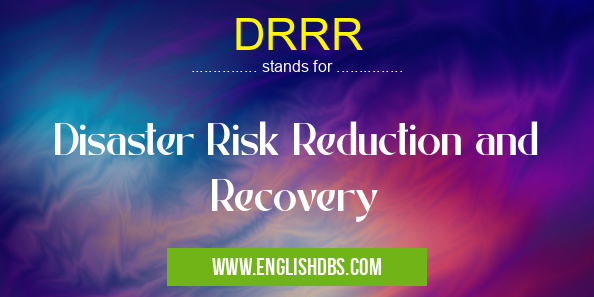What does DRRR mean in UNCLASSIFIED
DRRR stands for Disaster Risk Reduction and Recovery, and it is an important part of creating a resilient community. The concept of DRRR involves identifying potential hazards and preparing to reduce the risk of those hazards becoming a disaster. It also includes plans for recovering from disasters that do occur so that communities can return to normal as quickly as possible.

DRRR meaning in Unclassified in Miscellaneous
DRRR mostly used in an acronym Unclassified in Category Miscellaneous that means Disaster Risk Reduction and Recovery
Shorthand: DRRR,
Full Form: Disaster Risk Reduction and Recovery
For more information of "Disaster Risk Reduction and Recovery", see the section below.
Benefits of Disaster Risk Reduction and Recovery
By taking proactive steps to reduce hazard risks through DRRR strategies, communities can not only reduce the impact of disasters but also save money in terms of property damage repairs and relief efforts. When communities are more prepared for a disaster event, they are better able to handle the repercussions without relying heavily on government aid or private donations. DRRR programs can also lead to greater overall resiliency among individuals living in an area exposed to potential natural disasters by raising awareness about best practices for preparing for them. This can help alleviate some of the trauma experienced during events like hurricanes or earthquakes by providing a sense of security through preparation activities beforehand.
Essential Questions and Answers on Disaster Risk Reduction and Recovery in "MISCELLANEOUS»UNFILED"
What is Disaster Risk Reduction and Recovery?
Disaster Risk Reduction and Recovery, also known as DRRR, is a process of minimizing losses caused by natural disasters such as earthquakes, floods, fires and landslides. DRRR focuses on prevention, preparedness, response and recovery related to disaster management. By assessing potential risks and establishing preventive measures in advance of disasters, DRRR can help reduce the number of people affected by disasters and shorten the time needed for recovery afterwards.
How does DRRR help minimize losses from natural disasters?
DRRR helps mitigate the impacts of natural disasters through effective risk assessment plans which identify potential risks before they occur. This includes increasing public awareness about risks posed by different types of disasters, helping communities plan for emergency response procedures and strengthening infrastructure in vulnerable areas to ensure that buildings are more resilient to damage in the event of a disaster.
Who is involved in DRRR initiatives?
There are a variety of stakeholders involved in implementing DRRR initiatives including governments at all levels (local, regional & national), non-government organizations (NGOs), private sector companies, international organizations and academic institutions. All stakeholders need to work together to ensure a comprehensive approach towards reducing risk and increasing resilience within communities through research, planning, implementation and evaluation activities.
What strategies can be used for DRRR?
Strategies for DRRR vary depending on the specific context but often include activities such as developing risk maps or early warning systems; strengthening existing infrastructure or building new infrastructure to reduce vulnerability; promoting public education campaigns about disaster risks; or introducing policies that require businesses or households to put into place protective measures such as insurance coverage.
What are some examples of successful DRRR projects?
There have been numerous successful projects worldwide that demonstrate the effectiveness of Disaster Risk Reduction and Recovery efforts. For example, a Japanese project focused on constructing tsunami walls around coastal towns was able to reduce the impact of a 2011 tsunami significantly thanks to their preparations ahead of time. Similarly in India's western state Gujarat — which experienced some severe earthquakes — there has been an ongoing effort since 2001 which has included multiple awareness campaigns targeting local populations as well as construction projects aimed at making buildings more earthquake-resistant.
How is technology used in DRR&R initiatives?
Technology plays an important role in helping with Disaster Risk Reduction & Recovery efforts due to its ability to provide near real-time data regarding weather patterns or seismic activity as well as better communication between various stakeholders involved with these initiatives. Early warning systems can be developed using technologies such as satellite imagery or mobile phones while social media networks can be leveraged for quickly sharing information about impending risks so that local populations can take appropriate safety measures accordingly.
Final Words:
In conclusion, DRRR is an essential strategy for protecting communities from disastrous events caused by both natural hazards and man-made incidents. Its emphasis on improving infrastructure, building resilience among individuals within a community, providing early warnings systems, educating citizens about disaster risk reduction activities, and having effective response plans if needed all helps reduce the financial and emotional impacts resulting from disasters events like floods or earthquakes.
